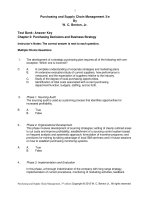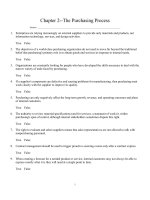Lecture Purchasing and supply chain management (3rd/e): Chapter 16 - W. C. Benton
Bạn đang xem bản rút gọn của tài liệu. Xem và tải ngay bản đầy đủ của tài liệu tại đây (658.89 KB, 15 trang )
Chapter 16:
Equipment Acquisition
and Disposal
Purchasing and Supply Chain Management
3rd edition
Purchasing and Supply Chain Management, 3rd edition, Copyright © 2013, W. C. Benton Jr., All rights reserved.
Purchasing and Supply Chain Management 3rd edition, Copyright 2013 W.
1
Capital Equipment Acquisition
•
The acquisition of capital equipment is a major decision
in most firms.
•
Made at a vice president level and above
•
Involve an expert equipment buyer
•
Industry specific
•
Significant long term expectation of returns
2
Purchasing and Supply Chain Management, 3rd edition, Copyright © 2013, W. C. Benton Jr., All rights reserved.
The Processes
Department Requisition
1.
•
A department requests equipment replacements and expansions
•
Involves the plant manager or the executive in charge of the
department
Company Goals And Objectives
2.
•
To compare the acquisition request with the overall longrun
objectives of the firm
•
e.g., maximize profitability
3
Purchasing and Supply Chain Management, 3rd edition, Copyright © 2013, W. C. Benton Jr., All rights reserved.
The Processes (cont.)
New Project Ideas
3.
•
Capital projects categories:
•
Replacements
•
•
Expansion (new products)
•
•
Increase quality, reduce operating expense, and provide more
efficiency
Expand into a newly introduced product line
Expansion (existing products)
•
An alternative to replacing the current equipment
•
Other (heating system for plant)
•
Other (new construction)
4
Purchasing and Supply Chain Management, 3rd edition, Copyright © 2013, W. C. Benton Jr., All rights reserved.
•
Other (renovation)
The Processes (cont.)
CashFlow Analysis
4.
•
Evaluate aftertax cash inflows and outflows of each capital
project alternative
•
Evaluation criteria:
•
•
The net cash investment
•
The net cash flow
•
The economic life of the project
Life cycle costing
•
An evaluation method used to evaluate alternative capital
acquisitions
Based on the total cost of the equipment over the expected life of
5
Purchasing and Supply Chain Management, 3rd edition, Copyright © 2013, W. C. Benton Jr., All rights reserved.
the product
•
The Processes (cont.)
Economic Evaluation
5.
•
Formal process of evaluating capital equipment or projects
•
5 common evaluation methods for individual projects:
a)
Payback
b)
Average rate of return
c)
Net present value
d)
Internal rate of return
e)
Profitability index
6
Purchasing and Supply Chain Management, 3rd edition, Copyright © 2013, W. C. Benton Jr., All rights reserved.
Comparison of Evaluation Methods
Method
Payback
Good Features
•
•
•
ARR
•
•
•
NPV
•
•
IRR
•
•
•
Pl
Easily understood
Easy to calculate
Provides a crude risk screen
Easily understood
Easy to calculate
Considers pastpayback cash
flows
Relatively easy to calculate
Best method for mutually
exclusive ranking problems
Easily understood
intuitive economic meaning
Okay on simple accept–reject
problems
Bad Features
•
•
•
•
•
•
•
Ignores the time value of prepayback
cash flows
Ignores pastpayback cash flows
Ignores the time value of any cash
flows
Hard to understand
May not work well in capital rationing
problems
Tedious to calculate
Does not work well on nonsimple
problems
Relatively easy to calculate
• Hard to understand
•
Best method for oneperiod capital • Doesn’t work well in some mutually
7
Purchasing and Supply Chain Management, 3rd edition, Copyright © 2013, W. C. Benton Jr., All rights reserved.
rationing problems
exclusive choice situations
•
The Processes (cont.)
Selection of Projects
6.
•
A accept–reject decision based on competition for limited funds
•
The hurdle rate may be based on:
•
The cost of capital
•
The opportunity cost
•
Other conceptual standards
8
Purchasing and Supply Chain Management, 3rd edition, Copyright © 2013, W. C. Benton Jr., All rights reserved.
The Processes (cont.)
Financial Plan Analysis
7.
•
Activities:
1)
2)
•
First, a comprehensive comparison of the selected
alternatives
Second, measure the planned project selections against the
initial company goals and objectives
Finance methods:
•)
Lease
•)
Purchase
9
Purchasing and Supply Chain Management, 3rd edition, Copyright © 2013, W. C. Benton Jr., All rights reserved.
Decision Factors Related To Finance
methods
•
Tax effect
•
Effects on future financing
•
Risk of obsolescence
•
Salvage value
•
Maintenance
•
Discount rate
10
Purchasing and Supply Chain Management, 3rd edition, Copyright © 2013, W. C. Benton Jr., All rights reserved.
Equipment Leasing
•
General Characteristics
•
During a fixed lease period
•
Lessee uses the capital equipment
•
Lessee plays a series of payments
•
•
•
e.g., monthly, semiannual, or annual payments
When the lease period ends, the equipment goes back to the
lessor
General Options:
Buy
11
Purchasing and Supply Chain Management, 3rd edition, Copyright © 2013, W. C. Benton Jr., All rights reserved.
•
Equipment Leasing (cont.)
•
Types of leases
•
Operating leases
•
•
Capital leases
•
•
Shortterm leases that can be cancelled during the contract
period
Cannot be cancelled during the lease period without a significant
penalty
Financial leases
•
A source of financing for companies that require positive cash
flows during the lease period
12
Purchasing and Supply Chain Management, 3rd edition, Copyright © 2013, W. C. Benton Jr., All rights reserved.
Disposal of Capital Equipment
•
In general, most firms have not yet designed a clean
process for the disposal of used equipment
•
For some firms, purchasing is usually charged with the task of
scrapping or selling retired equipment
•
For others, it is the vendor’s responsibility
13
Purchasing and Supply Chain Management, 3rd edition, Copyright © 2013, W. C. Benton Jr., All rights reserved.









